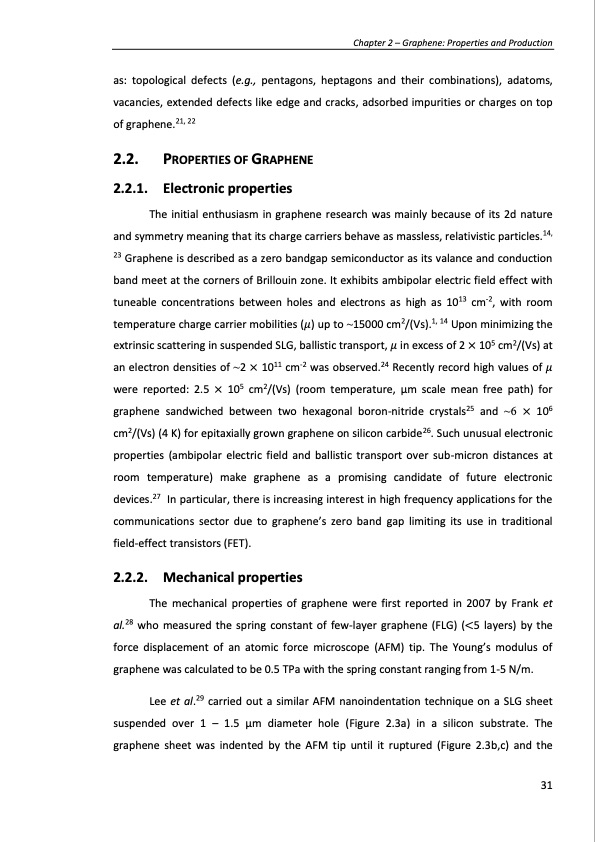PDF Publication Title:
Text from PDF Page: 031
as: topological defects (e.g., pentagons, heptagons and their combinations), adatoms, vacancies, extended defects like edge and cracks, adsorbed impurities or charges on top of graphene.21, 22 2.2. PROPERTIES OF GRAPHENE 2.2.1. Electronic properties The initial enthusiasm in graphene research was mainly because of its 2d nature and symmetry meaning that its charge carriers behave as massless, relativistic particles.14, 23 Graphene is described as a zero bandgap semiconductor as its valance and conduction band meet at the corners of Brillouin zone. It exhibits ambipolar electric field effect with tuneable concentrations between holes and electrons as high as 1013 cm-2, with room temperature charge carrier mobilities (𝜇) up to ~15000 cm2/(Vs).1, 14 Upon minimizing the extrinsic scattering in suspended SLG, ballistic transport, 𝜇 in excess of 2 × 105 cm2/(Vs) at an electron densities of ~2 × 1011 cm-2 was observed.24 Recently record high values of 𝜇 were reported: 2.5 × 105 cm2/(Vs) (room temperature, μm scale mean free path) for graphene sandwiched between two hexagonal boron-nitride crystals25 and ~6 × 106 cm2/(Vs) (4 K) for epitaxially grown graphene on silicon carbide26. Such unusual electronic properties (ambipolar electric field and ballistic transport over sub-micron distances at room temperature) make graphene as a promising candidate of future electronic devices.27 In particular, there is increasing interest in high frequency applications for the communications sector due to graphene’s zero band gap limiting its use in traditional field-effect transistors (FET). 2.2.2. Mechanical properties The mechanical properties of graphene were first reported in 2007 by Frank et al.28 who measured the spring constant of few-layer graphene (FLG) (<5 layers) by the force displacement of an atomic force microscope (AFM) tip. The Young’s modulus of graphene was calculated to be 0.5 TPa with the spring constant ranging from 1-5 N/m. Lee et al.29 carried out a similar AFM nanoindentation technique on a SLG sheet suspended over 1 – 1.5 μm diameter hole (Figure 2.3a) in a silicon substrate. The graphene sheet was indented by the AFM tip until it ruptured (Figure 2.3b,c) and the Chapter 2 – Graphene: Properties and Production 31PDF Image | PRODUCTION AND APPLICATIONS OF GRAPHENE AND ITS COMPOSITES

PDF Search Title:
PRODUCTION AND APPLICATIONS OF GRAPHENE AND ITS COMPOSITESOriginal File Name Searched:
graphene-production-applications.PDFDIY PDF Search: Google It | Yahoo | Bing
Salgenx Redox Flow Battery Technology: Power up your energy storage game with Salgenx Salt Water Battery. With its advanced technology, the flow battery provides reliable, scalable, and sustainable energy storage for utility-scale projects. Upgrade to a Salgenx flow battery today and take control of your energy future.
CONTACT TEL: 608-238-6001 Email: greg@infinityturbine.com (Standard Web Page)